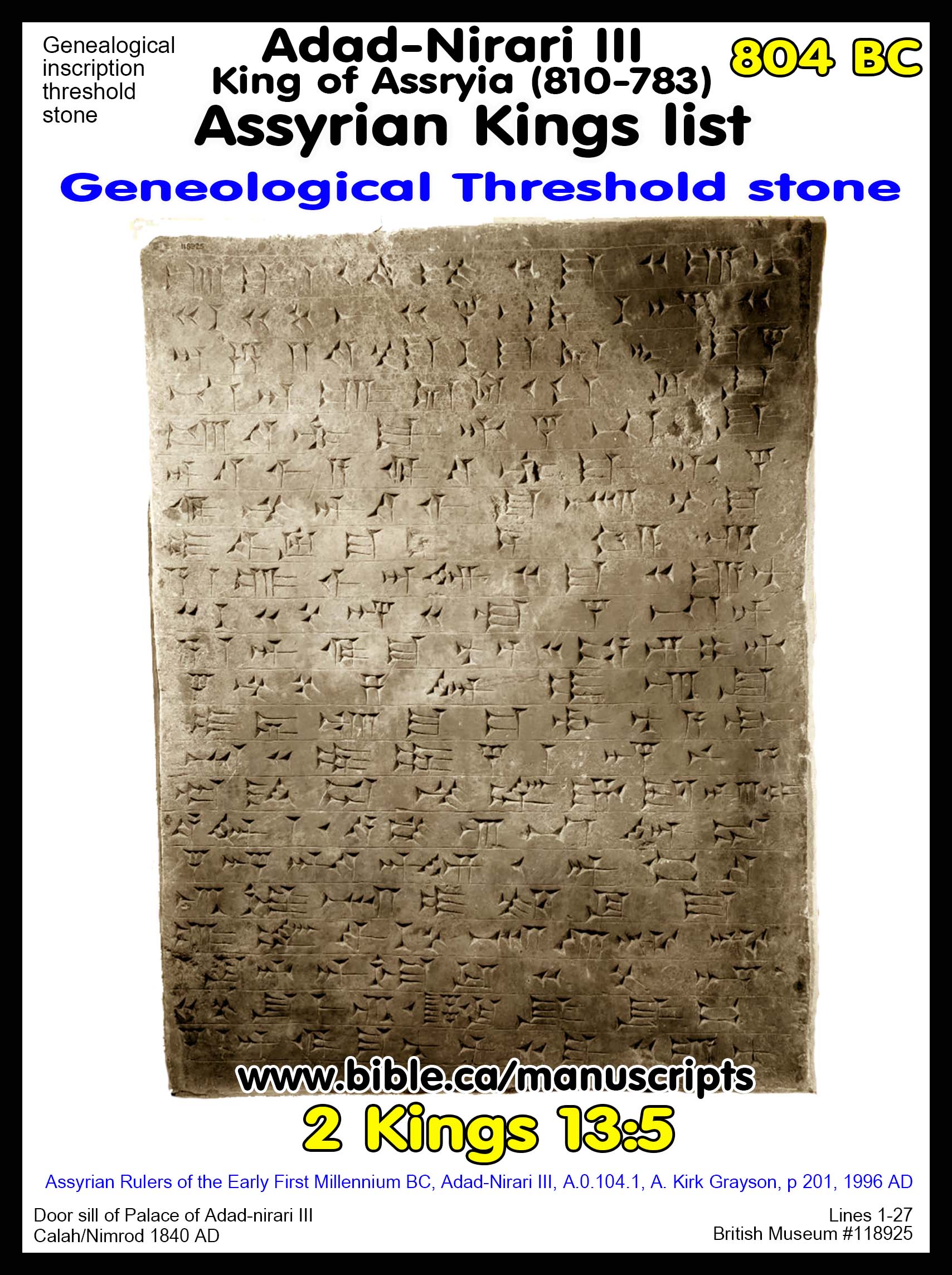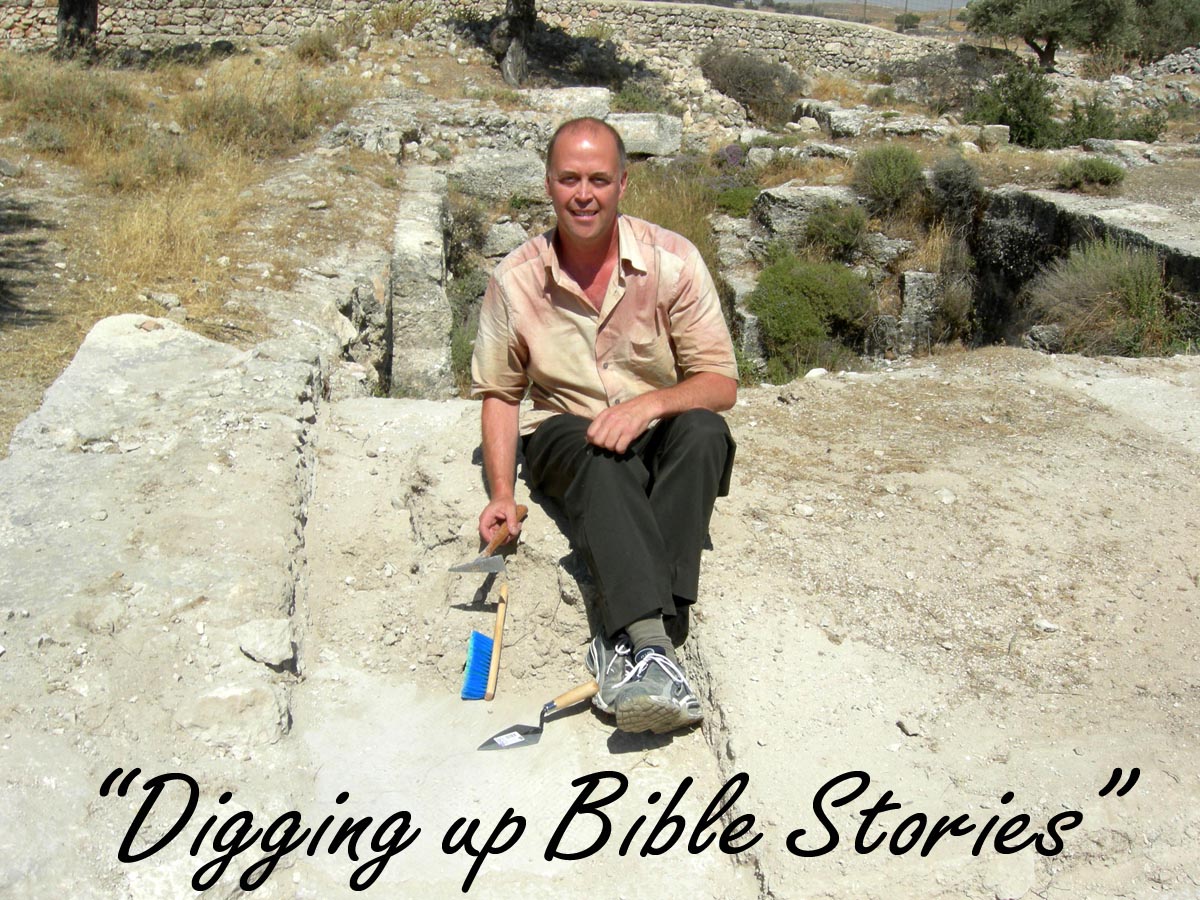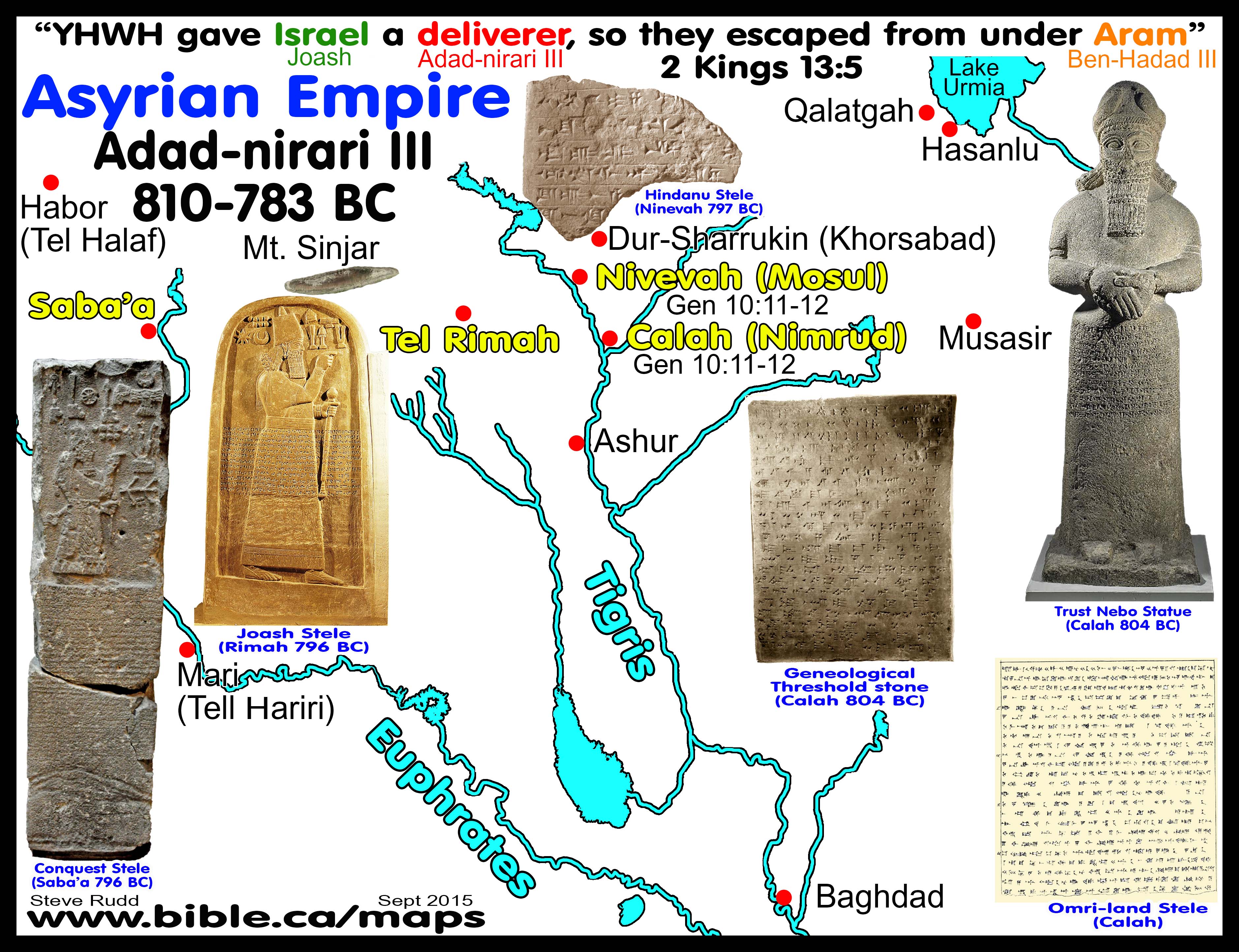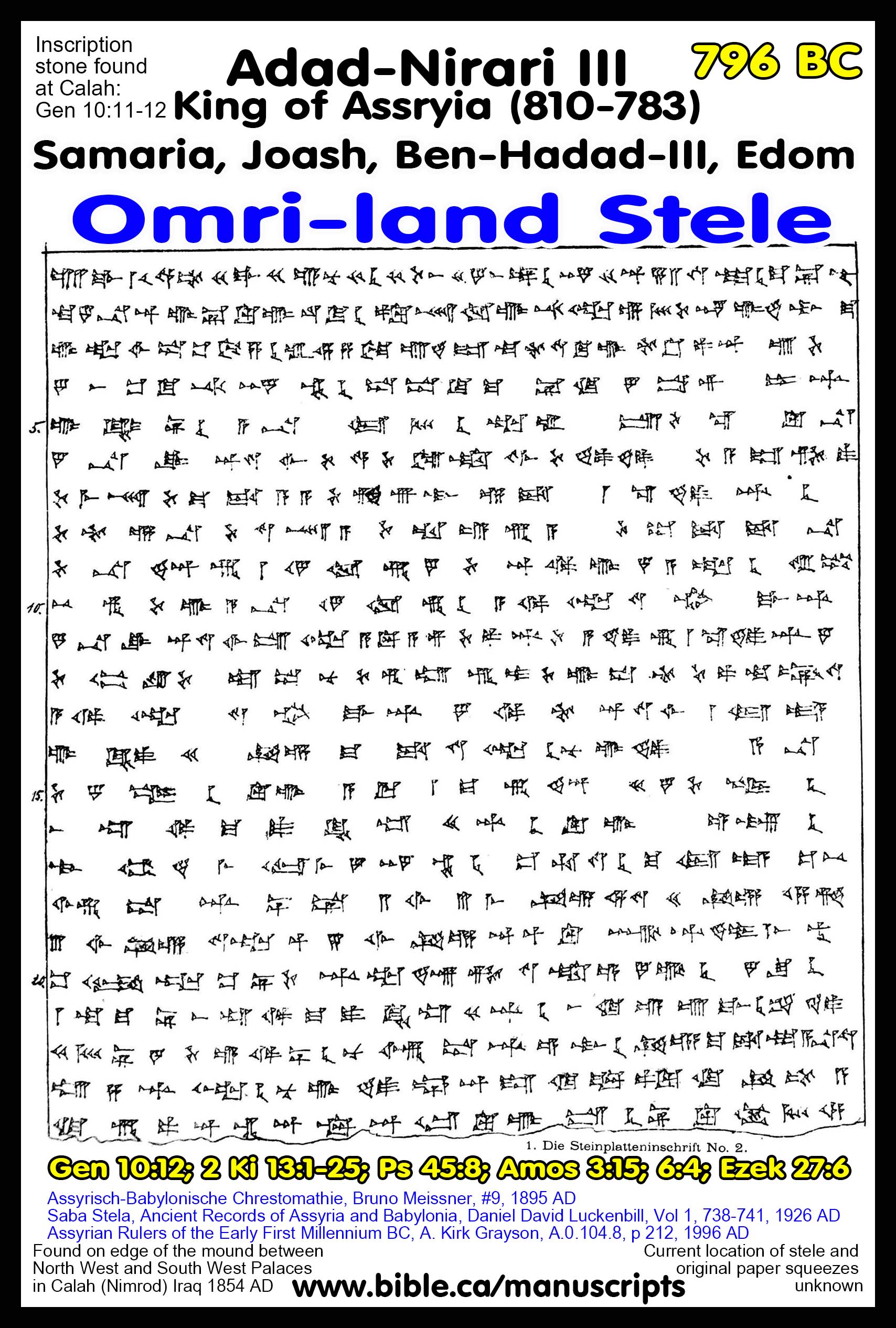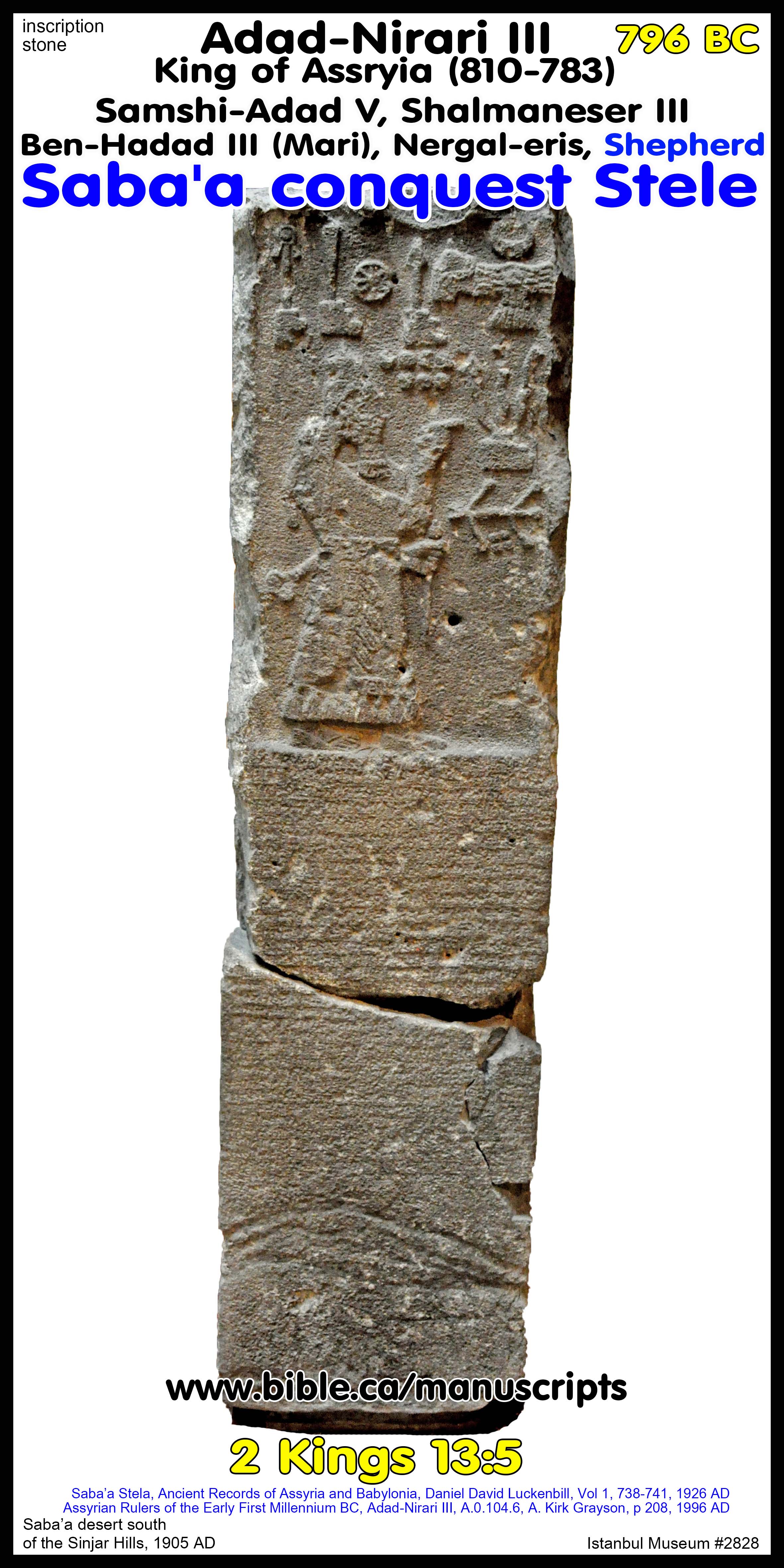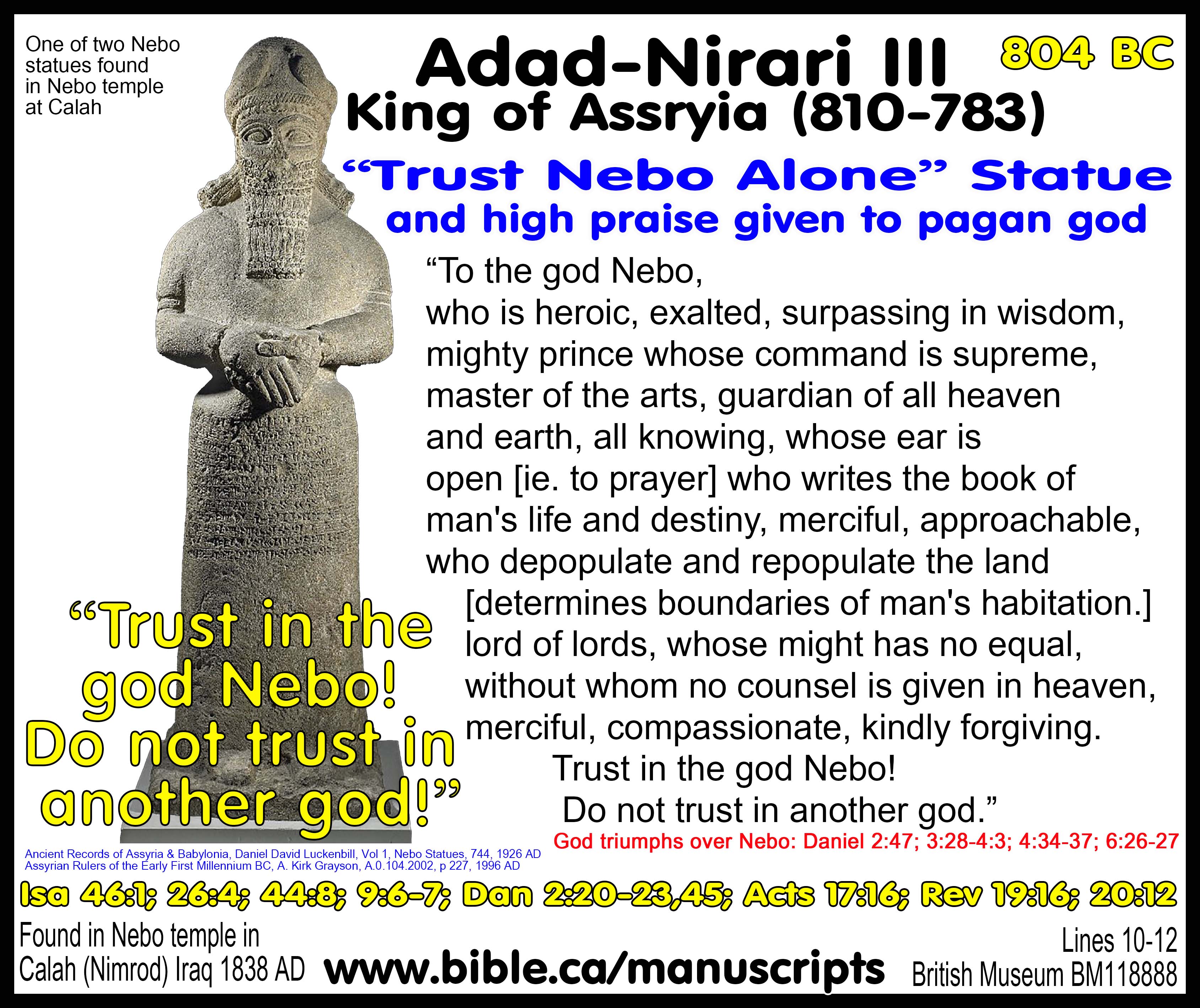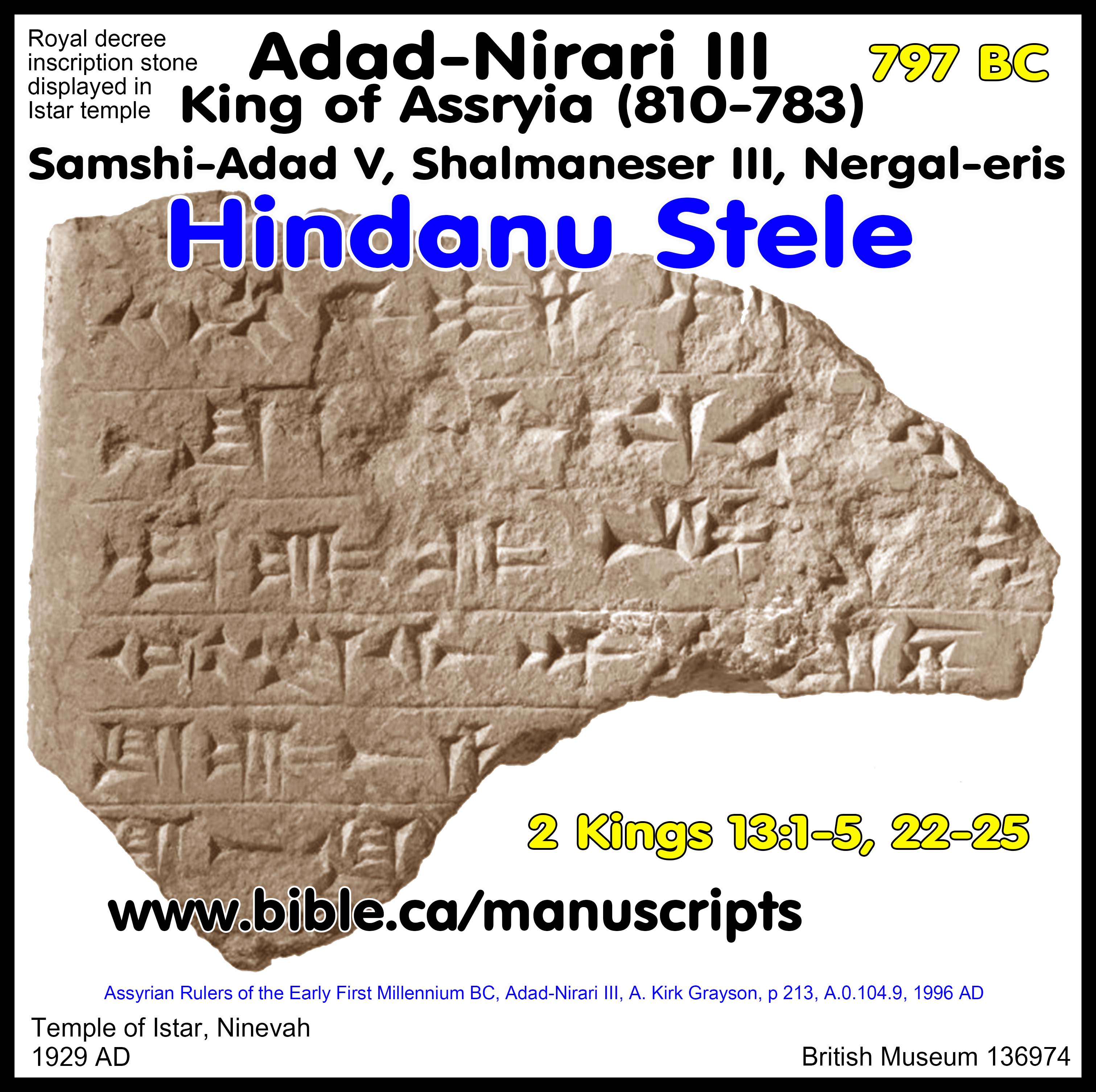Adad-Nirari III, King of Assyria (810-783)
List of Assyrian Kings in the Bible
|
Adad-Nirari III (810 - 783 BC) "The unknown deliverer" |
||
|
2 Kings 13:5 |
||
|
"YHWH gave Israel King Jehoahaz & Joash (Israel) |
a deliverer King Adad-nirari III (Assyria) |
they escaped Aram" King Ben Hadad III (Aram) |
Genealogical exemplar threshold stones from Calah/Nimrod of Adad-nirari III
Inscription on Stone Slab found at Calah (Nimrod)
|
Assyrian Kings List of Adad-nardi III: 804 BC "Palace of Adad-nardri (III), king of Assyria … Son of Samsi-Adad (V) … (grand)son of Shalmaneser (III) … (great) grandson of Ashurnasirpal (II) … offspring of Tukulti-Ninurta (I) … offspring of Shalmaneser (I) … offspring of Ilu-kabkabi (Enlil-kapkapi) … [offspring of] Sulili, whose name from old was called Assur…"
|
|
Digging up Bible stories!
The amazing Assyrian Kings list is a genealogical and dynastic record of the ancestors of Adad-Nirari III, King of Assyria (810-783). Although only Adad-nirari III is indirectly referenced in one bible passage (2 Ki 13:5) it gives us solid information about the Assyrian kings back to the time of David.
Detailed outline on Adad-Nirari III "What we read in the book, we find in the ground" |
Introduction:
- For a complete list of Assyrian kings see: Detailed outline on Adad-Nirari III
- This amazing alabaster door sill with a genealogical inscription was placed in the doorway of a palace built during reign of Adad-nirari III (810-783) in Calah (Nimrod).
- A stone door sill, known also as a threshold stone, is the bottom portion of a doorway flush with the ground.
- Some threshold door sills had holes and raised areas to stop the door from swinging any further than flush with the wall.
- All modern doors have sills. They are the bottom section you can step your foot on as you pass through the doorway.
- Messages on door sills and paving stones directly beside a door is archeological common.
- Messages on threshold stones was a kind of "WECOME MAT" for those to enter in.
- Often threshold stones would identify the owner of the building OR those who built the building
- In the Byzantine era (350-700 AD) little stone cubes of many different natural colours called "tesserae" were placed into concreate directly outside the doors to mark the significance or location of that monastery.
- There are many examples of tesserae being used to write
messages on floors I these little multi-coloured stones (white, red,
brown, black) in both Hebrew Greek and other languages. The rest of the
floor was made of the same materials and would often feature a geometric
design.
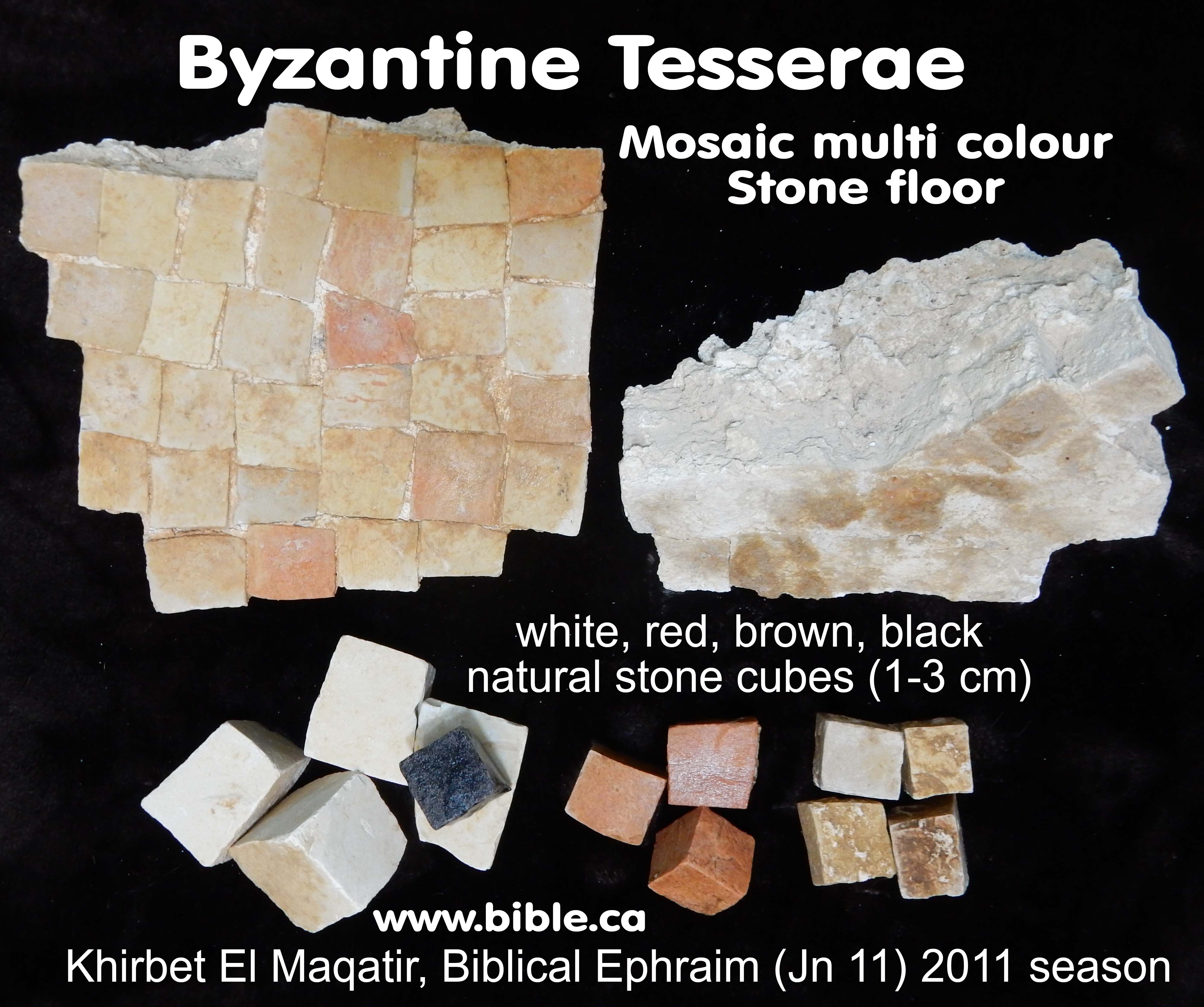
- Adad-narari III (810-783 BC) is the one God sent to deliver Israel in 2 Kings 13:5: "The Lord gave Israel a deliverer [Adad-narari III], so that they escaped from under the hand of the Arameans [Ben-Hadad III]; and the sons of Israel lived in their tents as formerly." (2 Kings 13:5)
- The names of the historic Assyrian kings chipped into stone in cuneiform, shows the Bible as a book of real history that can be trusted!
- This amazing archeological door sill names many of the Assyrian kings who ruled during the kings of Judah and Israel:
|
Name of Assyrian King |
Genealogical Door sill Adad-Nirari III (804 BC) |
Bible text |
|
Enlil-kapkapi (1800 BC?) |
|
- |
|
Sulili (1800 BC?) |
|
- |
|
Assur-Dan II (934-912 BC) |
|
- |
|
Adad-nirari II (911-891 BC) |
|
- |
|
Tukulti-Ninurta II (890-884 BC) |
|
- |
|
Assurnasirpal II (883-859 BC) |
|
- |
|
Shalmaneser III (858-824 BC) |
|
- |
|
Samsi-Adad V (823-810 BC) |
|
- |
|
Adad-narari III (810-783 BC) |
|
Delivers Israel: 2 Kings 13:5 |
|
Shalmaneser IV (782-773 BC) |
|
- |
|
Assur-dan III (772-755 BC) |
|
- |
|
Assur-narari V (754-745 BC) |
|
- |
|
Tilgath-pileser III/Pul (744-727 BC) |
|
Menahem, king of Israel, pays tribute to Pul of 1000 talents of silver for protection in 742 BC: 2 Kings 15:19 Ahaz king of Judah, pays tribute to Pul for protection against Aram in 742 BC:2 Kings 16:7 |
|
Shalmaneser V (726-722 BC) |
|
Hoshea paid tribute in 726 BC: 2 Kings 17:3 Captivity of Israel in 723 BC: 2 Kings 17:6; 18:9 |
|
Sargon II (721-705 BC) |
|
Capture of Ashdod in 713 BC: Isaiah 20:1 |
|
Sennacherib (704-681 BC) |
|
Attacks Jerusalem, Hezekiah builds famous water tunnel and city walls in 701 BC: 2 Kings 18:13 |
|
Esarhaddon (680-669 BC) |
|
2 Kgs 19:37, Isa 37:38; Ezra 4:2 |
|
Ashurbanipal (668-627 BC) |
|
Manasseh deported to Babylon after 648 BC, then returned to power: 2 Chron. 33:10-13 (see note #1 below) |
|
Ashuretililani (626-623 BC) |
|
- |
Note #1: Ashurbanipal (668-627 BC): "The Chronicler relates that Manasseh’s stubborn refusal to heed the warning of the prophets led to his deportation to Babylon by the Assyrians (2 Chron. 33:10–13). The Assyrian monarch responsible was, clearly, Ashurbanipal (668–627), son and successor to Esarhaddon. The reference to Babylon as Manasseh’s destination provides a helpful chronological clue, since Ashurbanipal did not bring Babylon under his control until 648. Manasseh could not have been taken there earlier. More information may be gained from Ashurbanipal’s annals, which recount an invasion of Egypt in 667 in which he eventually took the city of Thebes with material assistance from Manasseh. The Assyrian text shows that Manasseh was a vassal of Ashurbanipal as early as 667. His removal to Babylon in 648 or shortly thereafter suggests that Manasseh had violated his arrangement with Ashurbanipal." (Kingdom of priests, Eugene Merrill, p447, 2008)
I. About the genealogical exemplar
threshold stones from Calah/Nimrod:
- This is catalogued by Grayson as A.0.104.1.
- Discovered around 1840 AD (1851 Layard, ICC pl. 70: exs. 2-3, copy), this monument is in the British Museum (BM 118925 and No. 611). The inscription was published in Cuneiform Inscriptions of Western Asia, H.C. Rawlinson, Bd. Vol 1, plate 35, No. 3, 1861 AD
- "There are three exemplars of this genealogy, and each varies in length. Exemplar A is 27 lines long, B is 26 and C is 2L Layard discovered the three inscriptions in his excavations at Calah in the 1840's. Exemplar B was rediscovered by Directorate General of Antiquities and Heritage in Iraq's 1993 excavation season at Calah and has been republished recently. An important finding from the rediscovery is that Exemplar B is not a 25 line inscription as previously thought, but a 26 line one. Hence, need for a new score of the inscriptions. The texts were originally set in the doorways of the upper chambers. Exemplar A was found in doorway c, Exemplar B was located in doorway b, and exemplar C in doorway a. The cuneiform copies of the exemplars B and C were first published by Layard in 1851. However, Exemplar B appears only as a variant of Exemplar C Exemplar C, the shortest inscription, is on display in the British Museum (BM 118925)in Gallery 8 (Nimrod Central Saloon), while exemplar B is in the Iraq Museum. The current location of exemplar A remains unknown. The inscription with the titles and epithets of Adad-nirari III. The second section then moves into a long genealogy. It is the longest of the three genealogies and ranges from Adad-nirari III to Enlil-kabkabi, the Assyrian King List's Ila-kabkabi, and Sulili—approximately 1000 years. The link between the king and his ancestors is in a linear fashion. That is, the genealogy follows a single line, without segmentation, or multiple lines.6 However, many kings were omitted from this lineage. Wilson refers to this type of genealogy as 'telescopic"?" (The Reign of Adad-nīrārī III, Luis Robert Siddall, p207, 1022 AD)
- "This text is inscribed on pavement slabs found at Calah. It begins with the royal name and epithets, followed by an extremely long genealogy going back approximately one thousand years. The main exemplar of the text ends here, while the other two exemplars end earlier, and this makes one suspect that these were on the first of a series of inscribed slabs with the annals of Adad-narari III. Such annals series are known for Ashurnasirpal II (RIMA 2 p. 192) and Shalmaneser III (A.0.102.3 and 15)." (Assyrian Rulers of the Early First Millennium BC, Adad-Nirari III, A.0.104.1, A. Kirk Grayson, p 201, 1996 AD)
II. Translation of genealogical threshold Stone of Adad-Nirari III:
- "(Lines 1-9a: Palace of Adad-nardri (III), great king, strong king, king of the universe, king of Assyria, the king in whose youth Aggur, king of the Igigu gods, chose and entrusted him with unrivalled rulership: he conquered and gained dominion over everything from the great sea in the east to the great sea in the west. (Lines 9b-27) Son of Samsi-Adad (V), great king, strong king, king of the universe, king of Assyria, unrivalled king, (grand)son of Shalmaneser (III), king of the four quarters, who slew all his enemies and annihilated (them) like a flood, (great) grandson of Ashurnasirpal (II), virile warrior who extended habitations, offspring of Adad-narari (II), attentive prince whom the gods Agiur, Samag, Adad, and Marduk assisted so that he extended his land, offspring of Tukulti-Ninurta (I), king of Assyria, king of Sumer and Akkad, offspring of Shalmaneser (I), great king, strong king, who enlarged Ebursagkurkurra, "the mountain of the lands," offspring of Ilu-kabkabi (Enlil-kapkapi), an earlier king, a predecessor from before the sovereignty of Sulili, whose name Assur called from of old." (Assyrian Rulers of the Early First Millennium BC, Adad-Nirari III, A.0.104.1, A. Kirk Grayson, p 202, 1996 AD)
- "Palace of Adad-nirari, the great king, the mighty king, king of the universe, king of Assyria, the king whom Assur, king of the Igigi, called in his youth and gave him (lit., filled his hand with) a kingdom without a rival: from the great sea of the rising sun to the great sea of the setting sun, his hand prevailed against (conquered), and he brought under his sway, every land (lit., all of everything), son of Shamshi-Adad, the great king, the mighty king, king of the universe, king of Assyria, the king without a rival; (grand)son of Shalmaneser, king of the four regions (of the world), who slew all of his foes and brought (them) low like a flood; (great-)grandson of Assur-nasir-pal, the valiant hero, who increased (lit., made wide) (the human) habitations; offspring of Adad-nirari, the exalted prince to whose aid Assur, Shamash, Adad and Marduk came and whose land they enlarged (made wide) ; descendant of Tukulti-Urta, king of Assyria, king of Sumer and Akkad; of the line of Shalmaneser, the mighty king, who enlarged Eharsagkurkurra, "the mountain of the lands" ; of the lineage of Bel-kapkapi, the former king, who lived before my day (lit., me),—even before the reign (kingship) of Sulili, whose glory Assur proclaimed from of old." (Saba Stela, Ancient Records of Assyria and Babylonia, Daniel David Luckenbill, Vol 1, 738-741, 1926 AD)
Conclusion:
- For a complete list of Assyrian kings see: Detailed outline on Adad-Nirari III
- This amazing archeological door sill names many of the Assyrian kings who ruled during the kings of Judah and Israel.
- Adad-narari III (810-783 BC) is the one God sent to deliver Israel in 2 Kings 13:5: "The Lord gave Israel a deliverer [Adad-narari III], so that they escaped from under the hand of the Arameans [Ben-Hadad III]; and the sons of Israel lived in their tents as formerly." (2 Kings 13:5)
- The names of the historic Assyrian kings chipped into stone in cuneiform, shows the Bible as a book of real history that can be trusted!
- What you read in the book, you find in the ground! Find me a church to attend in my home town this Sunday!
|
2 Kings 13:5 |
||
|
"YHWH gave Israel King Jehoahaz & Joash (Israel) |
a deliverer King Adad-nirari III (Assyria) |
they escaped Aram" King Ben Hadad III (Aram) |
|
Conquest Stela of Adad-Nirari III (810 - 783 BC) Detailed outline on Adad-Nirari III . |
||
|
Religious and dynastic Stela of Adad-Nirari III (810 - 783 BC) |
||
By Steve Rudd: Contact the author for comments, input or corrections.
